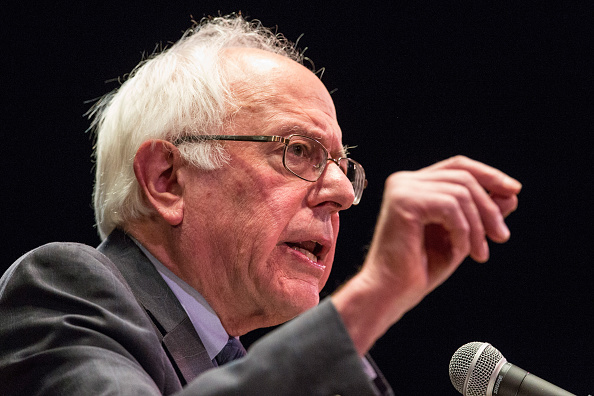
A high-profile presidential candidate has seen a massive advertising blitz, yet his standing in the polls has barely budged.
No, it’s not Republican Jeb Bush. Rather, it’s Bernie Sanders, who’s stealthily revved his advertising machine and is now out-gunning Democratic front-runner Hillary Clinton on television.
In December alone, the Sanders campaign aired about 7,650 TV ads, according to a Center for Public Integrity review of broadcast and national cable ad data provided by Kantar Media/CMAG.
That’s about one TV ad every six minutes.
The Sanders campaign had eschewed TV advertising altogether until late last year.
This December blitz also amounts to nearly one-third more ads than the Clinton campaign, which aired about 5,860 TV ads last month — one every eight minutes.
The Sanders campaign is also, of late, pouring more cash into TV ads than Clinton.
Read More: Iowa Caucus Math Gives Sanders A Boost
Since early November, when Sanders’ first launched presidential campaign ads, his campaign has spent about $9.7 million, according to a Center for Public Integrity review of data provided by The Tracking Firm, a recently formed nonpartisan media tracking company headquartered in Washington, D.C.
During that same period, Clinton’s campaign spent only $7.4 million. (The Democratic Party front-runner has spent about $14 million on TV ads since the beginning of August.)
Yet most polls in Iowa and New Hampshire, where the bulk of these TV ads have been focused, show little fluctuation since Sanders’ started his advertising barrage. Those two states conduct the nation’s first presidential nominating contests next month.
In Iowa, Clinton maintains more than a 10-percentage point lead over Sanders, according to a Huffington Post average of recent polls.
In New Hampshire, which borders Vermont, the state Sanders represents in the U.S. Senate, the race is tighter.
The Huffington Post’s average of recent polls currently gives Sanders about a three-point lead — essentially unchanged since the start of November.
During August, Sanders led Clinton in eight of nine polls of Granite State voters. But his lead has narrowed ever since — especially following Vice President Joe Biden’s late October announcement that he would not run for president.
Sanders campaign spokesman Michael Briggs told the Center for Public Integrity that Sanders is “feeling good about his chances” in both Iowa and New Hampshire.
“These ads are helping,” Briggs said. “The more people know about Bernie and his ideas, the more people like him and the things he’s talking about doing to fix the rigged economy and changing the corrupt campaign finance system.”
Read More: Why Conservatives Praise Bernie Sanders on Immigration
But one professional ad tracker says Sanders’ ads, which have all cast the senator in a positive light, have not yet paid off.
“Those seeking evidence that TV ads aren’t having their typical impact this time around will find it twofold in the fact that Sanders’ ads don’t seem to be moving his numbers, after his numbers initially surged without any ads at all,” said Elizabeth Wilner, the senior vice president of Kantar Media who oversees its Campaign Media Analysis Group.
Overall, the Sanders campaign raised about $73 million in 2015, mostly from people contributing $200 or less. The Clinton campaign raised $112 million during that time — the bulk of which has come from people giving $1,000 or more.
“We do have the resources to wage a very serious campaign,” Briggs said, who also noted the campaign recently surpassed one million individual campaign donors.
Representatives of the Clinton campaign did not respond to requests for comment.
At this stage of the 2008 presidential campaign, Clinton had raised $118 million, while Barack Obama had raised about $104 million.
Read More: Clinton Aired One-Fourth of All 2016 Campaign Ads So Far
Clinton has also been buoyed by a network of super PACs, which can collect contributions of unlimited amounts.
So far, these groups — the most prominent of which is known as Priorities USA Action — have largely stayed off the TV airwaves. But they certainly have the resources to pound the Sanders campaign with incessant negative ads should they so choose.
Sanders has disavowed super PACs, although one super PAC connected to a nurses’ union has spent more than $800,000 on his behalf. The bulk of that money has supported printing costs and a pro-Sanders bus tour, not TV ads.
This story is from the Center for Public Integrity, a nonprofit, nonpartisan investigative media organization in Washington, D.C. Read more of its investigations on the influence of money in politics or follow it on Twitter.
More Must-Reads from TIME
- Donald Trump Is TIME's 2024 Person of the Year
- Why We Chose Trump as Person of the Year
- Is Intermittent Fasting Good or Bad for You?
- The 100 Must-Read Books of 2024
- The 20 Best Christmas TV Episodes
- Column: If Optimism Feels Ridiculous Now, Try Hope
- The Future of Climate Action Is Trade Policy
- Merle Bombardieri Is Helping People Make the Baby Decision
Contact us at letters@time.com